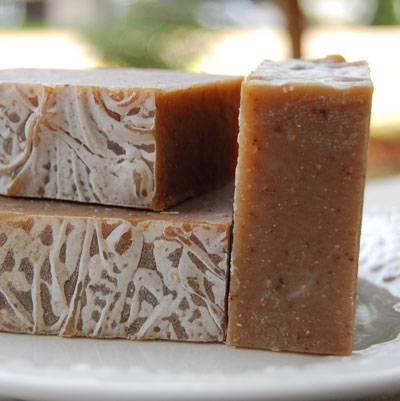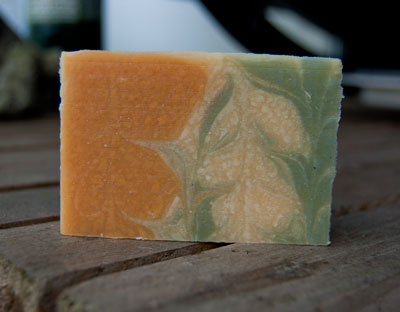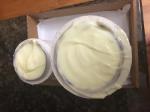Soap Troubleshooting Guide
Your soap making adventure has suddenly gone sideways and you need a soap troublemaking guide to figure out what the heck happened and how to fix it!
Some of the links on this site are affiliate links. If you buy a product through them, I receive a small commission which helps me provide the free information you find on this site. Thank you for your support!
Below you will find many common problems that can occur to soap makers and some suggestions on what to do to fix them.
What Went Wrong?
- Your soap feels oily.
- Your soap is soft & crumbly.
- Your soap is hard & crumbly.
- Your soap has oil &/or lye pockets.
- Your soap has cracks, craters or mountains.
- Your soap batter won't trace.
- Your soap has curdled in the pot.
- Your soap has seized in the pot.
- Your soap is separating in the mould.
- Your soap has white powder on it.
- Your soap has a dark centre.
- Your soap has brown or orange spots.
- Your soap changed colour during the cure.
- Your soap bars have tiny air bubbles.
Your Soap Feels Oily
Possible causes:
- Not enough lye was used in the recipe.
- Your soap was not properly traced when it went in the soap mould.
- Too much oil was added to your recipe or your super-fat is too high.
Things to check:
Run your recipe through a lye calculator to verify your lye amount.
Make sure your scale is operating properly.
Check your lye to see if it has absorbed excess moisture. If the grains or flakes stick together in clumps and do not flow nicely, you may need to buy new lye.
If the lye is new, check that the lye is pure. That means it is or is very close to 100% lye. The only ingredient should be sodium hydroxide. Sometimes the packaging will say 98% and the two percent is an allowance for moisture. As long as the allowance is very small, it should be fine.
How to fix it:
If your soap is oily due to a shortage of lye/excess oil it is difficult to fix. Since there is usually no way to know how much lye you need to correct the problem, it isn’t practical or safe to try and add more lye and re-batch. This could easily result in a lye heavy soap which is far worse than a lye short soap. One option is to leave the soap to fully cure and use it as a lotion type bar for the shower.
Another option is to shred the soap and incorporate it into new batches of soap. Any excess oil in the small bits will be absorbed by the saponification process of the new batches. Just don’t overload the new batch.
If you think the problem is due to the soap not having reached a full trace before being moulded, simply re-batch the soap and that will force the saponification process to complete properly.
Your Soap is Soft & Crumbly
Possible causes:
- Not enough lye was used in the recipe.
- The soap did not go through the gel phase.
- Too much liquid was used in the recipe.
- The recipe is mainly soft oils.
Things to check:
Run the recipe through a lye calculator to make sure it is accurate.
Check that your scale is operating correctly.
Add up the amount of liquids in the recipe. They should be equal to or less than 40% by weight of the oils.
Make sure your lye is pure and has not absorbed excess moisture. If the grains or flakes do not flow nicely and clump together, you may need to buy new lye.
If the lye is new, check that the lye is pure. That means it is or is very close to 100% lye. The only ingredient should be sodium hydroxide. Sometimes the packaging will say 98% and the two percent is an allowance for moisture. As long as the allowance is very small, it should be fine.
Did your soap go through the gel phase? This is when the soap heats up while insulating, darkens considerably and becomes jelly like.
How to fix it:
If your soap is soft and crumbly due to using mainly soft oils, not going through the gel phase or excess liquids, leave the soap to cure for longer. A longer cure time will give the soap time to fully saponify and to lose the excess moisture. Given enough time the soap will become much harder.
Another option to try if you want faster results is to re-batch the soap. The cooking process will help get rid of excess moisture and will complete the saponification process.
If you want harder soap next time, up the amount of hard oils, gel the soap and keep the liquid amount to a maximum of 40%.
If the problem is not enough lye, it can be difficult to fix since it is unlikely you know how much lye you need to add to the soap to fix it. You can try shredding it and adding it to another batch of soap and hot process it. Or just let the soap cure and keep it as a lotion like shower soap.
Your Soap is Hard & Crumbly
Possible causes:
- Too much lye used in the recipe.
- Not enough water used.
- The recipe is very high in hard oils.
Thinks to check:
Run the recipe through a lye calculator to make sure it is accurate.
Make sure your scale is measuring correctly.
Zap test your soap or use Phenolphthalein to check if your soap is lye heavy.
Check to see how much total liquid is used in your recipe. The standard amount used for a full water batch of soap is about 40% liquid by weight of oils.
How to fix it:
When a soap recipe is very low in water or very high in hard oils, it is best to try and cut as soon as it is firm enough to handle. That means the soap will still likely be hot when you cut it. If you want the soap to be more easily cut, next time increase the amount of liquid to between 30%-40% and reduce the amount of hard oils in the recipe.
If your soap is hard and crumbly due to too much lye, it is more difficult to fix. As is, the soap is unsafe to use. You could try to re-batch the soap adding in more oils. The problem with this is that you likely don’t know how much oil you need to make the soap safe to use. If you do attempt to fix the soap using this method, be sure to purchase some Phenolphthalein so you can make sure the soap has the right pH before you use it.
Your Soap Has Oil &/or Lye Pockets
Possible causes:
- Too much lye used in the recipe.
- Soap was poured before a full trace was reached.
Things to check:
Run the recipe through a lye calculator to make sure it is accurate.
Check that your scale is operating correctly.
Make sure that when stirring the soap you did not use the stick blender too much.
A stick blender is a great tool but it should only be used as an aid to stirring and not as the only tool. For a nicely blended emulsion, stick blend in short 3 – 5 second bursts followed by hand stirring. The hand stirring can be with a whisk, spoon or with the stick blender not turned on.
Over use of the stick blender can make the soap very thick and it can resemble traced soap. Always hand stir the soap before pouring to insure the soap has actually reached trace. If the soap base loosens up a lot with hand stirring, it is not yet ready to pour.
How to fix it:
If your soap has oil pockets, chop up the soap and re-batch it. Be sure to check the soap using Phenolphthalein to make sure the soap is safe for use once it is done.
If your soap has lye liquid pockets, it is more difficult to fix. As is, the soap is unsafe to use. You could try to re-batch the soap adding in more oils. The problem with this is that you likely don’t know how much oil you need to make the soap safe to use. If you do attempt to fix the soap using this method, be sure to purchase some Phenolphthalein so you can make sure the soap has the right pH before you use it.
Your Soap Has Cracks, Craters or Mountains
It can also look like
‘alien brains’ or have clear glycerine streaks that look like a crackle effect.
In extreme cases the soap has expanded in volume and is overflowing the soap
mould.
Possible causes:
- The soap has overheated.
Things to check:
Does the recipe have sugar? This can include any sweets such as honey, milks, fruit puree and vegetable purees.
How hot of a temperature were the oils and lye solution combined at?
Was the soap insulated?
How to fix it:
The soap is overheating and needs to cool down. Remove any insulation and place it in a cool location. Place it on a wire rack so air flows below the soap mould as well.
If the center of the soap has risen, gently push it back down using your spatula.
If the soap has an alien brains or crackle look...embrace it. There isn’t much you can do and many people will think it’s cool! If it bugs you too much you can always re-batch it.
If the soap is crawling out of the soap mould and resembles hot process soap, scoop it up and put it back in the soap mould. Use your spatula to clean up the look as best you can. It may not be the most beautiful batch you’ve made but it will still be soap.
When using recipes that contain any form of sugar product, it is important to mix at lower temperatures as the sugar reacts as a catalyst with the lye and heats up much faster and hotter than normal.
Be sure to check the soap often once it is in the mould and remove any insulation material as soon as the soap reaches a full gel.
Your Soap Batter Won't Trace
Possible causes:
- Not enough lye in the recipe.
- There is too much liquid in the recipe.
- The recipe is very high in unsaturated fats like olive oil.
- Stirring is inconsistent.
Things to check:
Run the recipe through a lye calculator to make sure it is accurate.
Check that your scale is operating correctly.
Check your lye to see if it has absorbed excess moisture. If the grains or flakes stick together in clumps and do not flow nicely, you may need to buy new lye.
If the lye is new, check that the lye is pure. That means it is or is very close to 100% lye. The only ingredient should be sodium hydroxide. Sometimes the packaging will say 98% and the two percent is an allowance for moisture. As long as the allowance is very small, it should be fine.
Are you using a stick blender in 3 – 5 second bursts alternating with hand stirring?
How to fix it:
If your soap is not tracing due to a high percentage of unsaturated fats such as olive oil, keep at it. These types of soap can take a long time to reach trace.
If you are hand stirring, consider using a stick blender or at the very least a whisk to mix the batter. A stick blender speeds up the process considerably and provides a more uniform emulsion if used correctly. Alternate hand stirring with stick blending in 3-5 second bursts until the soap is nicely traced. Then hand stir for a bit to make sure the soap is truly reached trace. If the batter loosens up quite a bit, repeat the stick blend/hand stir process.
Your Soap Has Curdled in the Pot
Possible causes:
- Often the cause of curdled soap is a reaction to fragrance oil.
Things to check:
Does the soap show signs of separation?
Do you see waxy like pearls in the soap batter?
How to fix it:
Some fragrance oils do not behave very well in soap making. When using a new fragrance that you have never used before, be sure to use the full water amount until you know how the oil behaves.
Many venders test their fragrances in various forms of products and can tell you how the oil will behave in your intended application and if it is suitable. Brambleberry is one supplier that tests vigorously.
Sadly, sometimes the oil just misbehaves regardless of any testing. If you encounter this problem and find your soap separating after you have added the fragrance oil, stir, stir, and stir some more. Usually a good mixing with a stick blender will help the soap batter achieve an emulsion. You will have to work fast once it does as it will likely be very thick.
Your Soap Has Seized in the Pot
Possible causes:
- The fragrance oil is reacting with the soap base.
- The recipe is high in saturated fats and low in water.
- An essential oil has sped up the saponification process.
Things to check:
Does your recipe call for the full amount of water? When using new fragrances, high amounts of saturated fats or fast moving essential oils like clove, it is a good idea to use the full 38 – 40% of water recommended.
Check your temperatures. It is best to soap between 90 and 120 degrees Fahrenheit.
How to fix it:
If your soap is still workable, get it scooped into your mould. Be sure to watch it in case it starts to overheat.
If you now have what is often called ‘soap on a stick’, it might be a good idea to finish this batch using the hot process method.
Your Soap is Separating in the Mould
Possible causes:
The soap was likely poured before it reached a full trace.
How to fix it:
Scrape out the soap from the mould and place it back in your pot. Stir it until a full trace has been reached and remould it.
Your Soap Has White Powder On It
Possible cause:
Hmmm....lots of ideas out there but I don't know for sure why this happens. I've read that it has something to do with the lye reacting to carbon dioxide that is present in the air.
How to fix it:
You can use steam and gentle rubbing to remove the ash deposit.
Next time when you pour the soap into the mould, spray the soap with a small bit of rubbing alcohol. This seems to help prevent soda ash formation.
Using distilled water, discounting the water in your recipe and allowing the soap to cool slowly may also help reduce the amount of ash.
Your Soap Has a Dark Centre
Possible cause:
This is called a partial gel.
When soap is going through the saponification process it can get really hot and will become dark and jelly like. This is referred to as ‘gelling’ your soap.
How to fix it:
Soap naturally wants to gel but sometimes it needs help to complete the process. Wrapping your soap in blankets will help keep the heat in and ensure a full gel. Be sure to check the soap every hour or so until it has fully gelled and then remove the blankets to let the soap cool down. We don’t want the soap to overheat.
You can put the soap in an oven that has been warmed to 170 degree Fahrenheit and then turned off. Leave the soap until it has fully gelled and then remove it from the oven to cool.
If your soap is already cool when you discover it has a partial gel, do not despair. It is an aesthetic problem only and will not affect the quality of your soap. If it bothers you too much you can re-batch the soap to give it a more even colour.
Your Soap Has Brown or Orange Spots
Brown or orange spots have formed on your soap and you have no idea why. This phenomenon is referred to as DOS - dreaded orange spot.
Possible cause:
- Rancid oils in your soap.
- Happens more often to soap that is high in unsaturated fats.
- Used pomace oil that contains a high percentage of olive sediment.
- Your soap has been exposed to excess moisture before use.
- Your soap has been stored in too warm of a location or in direct sunlight.
How to fix it:
Make sure to purchase fresh oils and store them properly. Cool, dark and dry locations are best. Some oils require refrigeration after opening.
An olive oil soap made with pomace oil is more likely to get DOS due to the high percentage of olive matter present in the soap.
Always store your handmade soaps in a cool, dark and dry location such as a linen cupboard. Only put soap in the bathroom once it is ready to be used. This will greatly lengthen the life of your soap.
Your Soap Changed Colour During the Cure
Possible cause:
Fragrance oil or essential oil reaction.
Things to check:
Did you use a fragrance oil to scent your soap?
If so, does the fragrance contain a vanilla component? Vanilla will most often turn your soap a dark brown. In fact vanilla is kind of fun...the outside of your soap will be dark but when you cut the soap it will have a white centre. Sadly the centre will start to darken as soon as it is in contact with the air.
Vanilla is not the only culprit. Many fragrance oils will turn your soap a different colour. Check with your supplier. A good supplier will test the fragrance oils in cold process soap making and let you know how the fragrance behaves. Both Natures Garden and Brambleberry test their fragrances.
Some essential oils will also change the colour of your soap. A good rule of thumb is to look at the colour of the essential oil itself. Is it a strong colour? Chances are it will tint or change the colour of your soap if it is.
How to fix it:
Once you've put a darkening fragrance or essential oil in a soap, there is no way to lighten the soap. It is there to stay.
Before using a fragrance or essential oil, research how it will perform in CP soap. Better to know what will happen ahead of time than be surprised after.
Titanium dioxide can be used to help lighten a soap but it will not stop the soap from darkening. Vanilla will still turn your soap dark brown but you could use the titanium dioxide in a swirl to give a tone on tone decorative feature.
Your best bet is to embrace what the oil will do and work with it.
Your Soap Bars Have Tiny Air Bubbles
Possible cause:
- Your stirring was too vigorous.
- The stick blender has whipped air into the soap batter.
How to fix it:
When stirring the soap batter be sure to use strong steady strokes but do not whip the soap vigorously.
The stick blender can capture air and fill your soap batter with small bubbles that become trapped.
When putting the stick blender into the soap, place it at an angle and tap it a few times on the bottom of the soap pot to dislodge any air that is trapped in the blender head. Once that is done you can turn the stick blender on.
While using the stick blender, be sure to keep the blender head under the surface of the soap batter. If the head comes up above the soap, it will grab air and whip it in.
Home › Soap Troubleshooting Guide




Facebook Comments